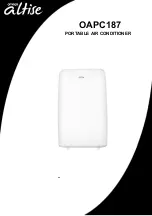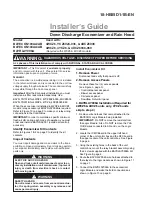
Refrigeration Maintenance
10-48
Installation
1. Clean the tubes for soldering.
2. Remove the coil and place the valve in position.
3. Install the valve mounting hardware if used.
4. Solder the inlet and outlet connections. After the valve cools, install the coil.
5. Pressurize the refrigeration system and test for leaks.
6. If no leaks are found, replace the liquid line drier then evacuate the system.
7. Recharge the unit with proper refrigerant and check the compressor oil.
SUCTION LINE CHECK VALVE TEST (MULTI-TEMP UNITS ONLY)
A suction line check valve prevents refrigerant from flowing back into its remote evaporator when its zone is in null or when
another zone is in defrost. A suction line check valve also prevents refrigerant from flowing back into its suction line when its
zone is in heat and another zone is in cool.
A leaking suction line check valve can reduce the heating or cooling capacity of the other zone (or zones) when its zone is in
null. A leaking suction line check valve can reduce the defrosting capacity of the other zone (or zones). A leaking suction line
check valve can reduce the heating and cooling capacities when its zone is in heat and the other zone (or zones) is in cool. Use
the following procedure to test the suction line check valves.
1. Attach a gauge manifold to the suction service valve and the discharge service port. Attach another low pressure gauge to the
suction access port located in the suction line near the accumulator inlet. Low loss fittings must be used on the hoses connected
to the discharge service port and the suction access port.
2. Operate the unit with all zones in low speed cool.
3. Front seat the receiver tank outlet valve and allow the low side to pump down to 0 to 5 in. Hg vacuum (0 to -17 kPa).
4. Turn the unit Off.
5. Front seat the suction service valve to isolate the low side while it is still in a vacuum.
6. Watch the low pressure gauge attached to the suction access port. The low side pressure should not rise. It it does, there could
be a leak through one (or more) of following components: hot gas solenoids, purge valve, or hot gas bypass solenoid.
7. Open the suction service valve and use the gauge manifold to raise the pressure in the low side to 5 to 20 psig (34 to 138 kPa).
Front seat the suction service valve to isolate the low side.
8. Watch the low pressure gauge attached to the suction access port. The low side pressure should not drop. It it does, one (or
more) of suction line check valves is leaking. Check the temperatures of the refrigeration lines on both sides of each suction
line check valve by hand. A temperature difference between the two sides of a suction line check valve indicates it is leaking.
9. Open the suction service valve and use the gauge manifold to raise the pressure in the low side to be equal with the high side
pressure. Front seat the suction service valve to isolate the low side.
10. Watch the low pressure gauge attached to the suction access port. The low side pressure should not drop. It it does, one (or
more) of suction line check valves is leaking. Check the temperatures of the refrigeration lines on both sides of each suction
line check valve by hand. A temperature difference between the two sides of a suction line check valve indicates it is leaking.
11. Back seat the receiver tank outlet valve and suction service valve. Perform a “Refrigerant Gauge Removal” procedure.
SUCTION LINE SOLENOID (SLS) TEST (MULTI-TEMP UNITS ONLY)
A suction line solenoid closes when a its zone is in heat and the other zone (or zones) is in cool. This is called reverse cycle
heat. The closed suction line solenoid forces the refrigerant to flow through the liquid return check valve into the liquid line and
prevents the refrigerant from flowing through the suction line.
A suction line solenoid that fails to close or leaks can reduce the heating and cooling capacities when its zone is in heat and
the other zone (or zones) is in cool. If a suction line solenoid stuck closed, its zone would not cool when all zones were in cool.
Use the following procedure to test the suction line solenoids.
1. Attach a gauge manifold to the suction service valve and the discharge service port. Attach another low pressure gauge to the
suction access port located in the suction line near the accumulator inlet. Low loss fittings must be used on the hoses connected
to the discharge service port and the suction access port.
2. Operate the unit with all zones in low speed cool.
3. Front seat the receiver tank outlet valve and allow the low side to pump down to 0 to 5 in. Hg vacuum (0 to -17 kPa).
4. Turn the unit Off.
CAUTION: Use a heat sink to prevent damage.
CAUTION: Do not run scroll compressor in a vacuum for more than 1 minute.
CAUTION: Do not run scroll compressor in a vacuum for more than 1 minute.
Содержание T-1000R
Страница 14: ...Safety Precautions 2 6 Warning Decals 2e24151g0 ...
Страница 18: ...Specifications 3 4 ENGINE CLUTCH Engagement 600 100 RPM Dynamic Torque 66 fT lb 89 5 N m minimum 1600 RPM ...
Страница 34: ...Maintenance Inspection Schedule 4 10 ...
Страница 57: ...Unit Description 5 23 Purge Mode UT Series 1 3 4 5 2 ...
Страница 67: ...Unit Description 5 33 Zone 1 Cool and Zone 2 Cool UT SPECTRUM Units ...
Страница 69: ...Unit Description 5 35 Purge Mode UT SPECTRUM Units ...
Страница 71: ...Unit Description 5 37 Zone 1 Cool and Zone 2 Heat UT SPECTRUM Units ...
Страница 72: ...Unit Description 5 38 ...
Страница 74: ...Diesel Electric Menu 6 28 Adjust Brightness 6 29 Time 6 30 ...
Страница 120: ...Operating Instructions Standard HMI 7 18 ...
Страница 152: ...Engine Maintenance 9 14 T Series Fuel and Oil System Components TK 376 ...
Страница 154: ...Engine Maintenance 9 16 T Series Fuel and Oil System Components TK 270 ...
Страница 156: ...Engine Maintenance 9 18 UT Series Fuel System Components AMA768 ...
Страница 172: ...Engine Maintenance 9 34 T Series Engine Mounting Components for 2 Cylinder Engine ...
Страница 184: ...Engine Maintenance 9 46 ...
Страница 238: ...Refrigeration Maintenance 10 54 ...
Страница 246: ...Clutch Maintenance 11 8 ...
Страница 258: ...Structural Maintenance 12 12 ...
Страница 264: ...Mechanical Diagnosis 13 6 ...
Страница 265: ...14 Electric Standby Diagnosis ...
Страница 268: ...Electric Standby Diagnosis 14 4 ...
Страница 269: ...15 Refrigeration System Diagnosis ...
Страница 272: ...Refrigeration System Diagnosis 15 4 ...
Страница 280: ...Remote Evaporators 16 8 ...
Страница 282: ...Wiring Diagrams and Wiring Schematics 17 2 ...
















































